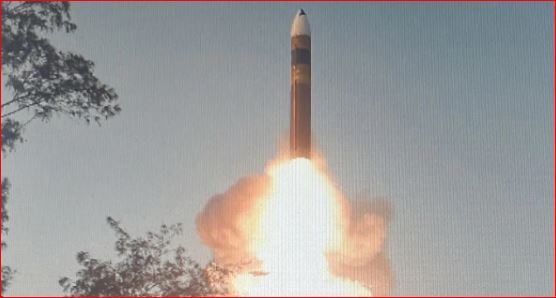In a significant development for India’s defence program, the Defence Research and Development Organisation (DRDO) carried out the first successful flight test of the indigenously developed Agni-5 missile equipped with Multiple Independently Targetable Re-entry Vehicle (MIRV) technology. The mission, named Divyastra, was launched from Dr APJ Abdul Kalam Island in Odisha on Monday.
The Agni-5 is an intercontinental ballistic missile with a striking range exceeding 7,000 km. MIRV technology allows a single missile to carry multiple warheads, each capable of targeting separate locations. This successful test marks a major leap forward in India’s missile capabilities, placing it among a select group of nations possessing MIRV technology.
The achievement comes after years of dedicated research and development by DRDO scientists. The Agni-5’s journey began with its maiden flight test in April 2012. Since then, it has undergone several successful tests in 2013, 2015, 2018, and 2020, progressively validating its capabilities. These tests focused on evaluating the missile’s performance across crucial areas:
• Propulsion: Testing different configurations of the solid and liquid fuel stages to ensure reliable and powerful launches.
• Navigation: Validating the onboard inertial navigation system and advanced guidance systems for precise targeting over long distances.
• Long-Range Accuracy: Demonstrating the missile’s ability to hit designated targets thousands of kilometers away with exceptional precision. The successful launches in 2018 and 2020 were particularly significant, showcasing the Agni-5’s ability to travel its full operational range.
Adding Teeth to the Tiger: The MIRV Advantage
The latest test with MIRV technology marks a significant evolution of the Agni-5 missile program. Previously, the Agni-5 could deliver a single warhead. Now, with MIRV, it can carry multiple independently targeted warheads, significantly enhancing its offensive potential. Experts suggest the tested configuration could carry between 2-3 warheads, but details remain undisclosed. This allows for greater flexibility in various scenarios:
• Multiple Target Engagement: The ability to strike multiple high-value targets simultaneously in a time-sensitive operation.
• Area Saturation: In a potential conflict, MIRV allows for saturating a broader defensive zone with warheads, overwhelming enemy defenses.
• Penetration of Advanced Missile Defense Systems: MIRV technology can potentially overwhelm missile defense systems designed to intercept single warheads.
Prime Minister Narendra Modi lauded the efforts of the DRDO team, calling Mission Divyastra a “moment of pride” for India.
Proud of our DRDO scientists for Mission Divyastra, the first flight test of indigenously developed Agni-5 missile with Multiple Independently Targetable Re-entry Vehicle (MIRV) technology.
— Narendra Modi (@narendramodi) March 11, 2024
Defence Minister Rajnath Singh also congratulated the scientists, terming the mission an “exceptional success.”
Also See:
https://bharatshakti.in/agni-5-to-brahmos-how-indias-missiles-are-adding-muscle-to-diplomacy/
In a career spanning three decades and counting, Ramananda (Ram to his friends) has been the foreign editor of The Telegraph, Outlook Magazine and the New Indian Express. He helped set up rediff.com’s editorial operations in San Jose and New York, helmed sify.com, and was the founder editor of India.com.
His work has featured in national and international publications like the Al Jazeera Centre for Studies, Global Times and Ashahi Shimbun. But his one constant over all these years, he says, has been the attempt to understand rising India’s place in the world.
He can rustle up a mean salad, his oil-less pepper chicken is to die for, and all it takes is some beer and rhythm and blues to rock his soul.
Talk to him about foreign and strategic affairs, media, South Asia, China, and of course India.





